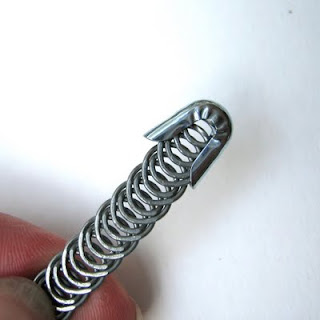There has been much talk of and use of spiral wire boning in blogland of late, so I thought i'd write a little bit about it.
Spiral wire boning is used in corsets and in couture garments for strong boning support. It is made of steel which has been formed into a continuous spring which has then been flattened. Because spiral wire boning is a flattened spring, it is extremely flexible and can bend horizontally and vertically (backwards, forwards and sideways), making it perfect for boning over and around curves.
 |
| The curvy bone channel goes from side to side as well as up and over |
In couture garments, it is used in conjunction with 2 layers of tulle or bobbinet which is a very fine and very strong netting material which when layered together, has no stretch but provides a fine, non bulky foundation for a gown.
 |
| a corset looks like a skeleton when held to the light |
In corsetry, sprial wire boning is used in conjunction with coutil fabric and often in partnership with flat sprung steel bones which are not as flexible and therefore useful when a firmer, straighter support is required. Both types of steel boning were invented during the Victorian age and used instead of whalebone because it was cheaper and easier.
Spiral wire boning comes in various different widths, from 4mm-15mm, and various different thicknesses making it possible to 'mix and match' your boning to achieve whichever level of support is required for any particular project. For instance, you may only need a light 5mm wire to bone a net bodice, but you may need a more robust 7-10mm wire to bone a multi-layer corset for tightlacing. With all boning, there is flexibility!
All types of boning, whether steel or plastic, comes either in pre-cut lengths or in continuous reels. It is more economical and much more efficient to buy your steel in a roll and cut it yourself but many people are put off by the supposed requirement for 'brute force' with which to cut it.
Do not fear!
Spiral wire boning is easy peasy to cut and tip.
Here is a tutorial to show you how.
To cut and tip spiral wire, you need a pair of wire cutters, and two pairs of pliers, one of which must have flat edges.
 |
| my flat pliers are out of shot! |
To cut the boning, you need only snip either side of the wire. When you have snipped the wire either side of the spring, it will come apart naturally.
Trim any pokeyouty bits with your wire cutters and then apply a metal end cap and push it on so that it feels quite secure.
Now this is the fiddly part - using both pairs of pliers, you need to squish the end cap onto the wire simultaneously from either side and top and bottom. Like this:
 |
| kindly modelled by Mr Marmalade |
Now you have a tip which is compressed onto the end of your wire
BUT ... sometimes, if you make a mistake after inserting the bone into a channel and you need to pull the bone out, the cap can come off in the channel leaving you with a nasty conundrum. To counter this, I use plumbers tape. It's cheap as chips and less messy than glue. You just wrap a bit on the join between wire and cap, and this holds it all together perfectly and makes it all a bit smoother.
Easy when you know how!

















7 comments:
I really love this - great information!
what a great and informative post. Thanks!
Thankyou both :)
Great tutorial as always Julia... good pictures too. :-)
Great hint about the plumbers tape!
Great post, thank you! I have first hand experience with this boning and it is great.
Great tip about the plumbers tape! I loooooove the spiral steel boning I used in my wedding gown - there is no way I'm going back to plastic anymore... It's counter-intuitive, but the steel boning is just so much more comfortable.
Post a Comment